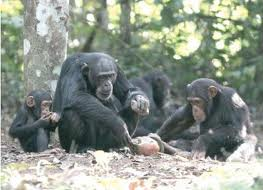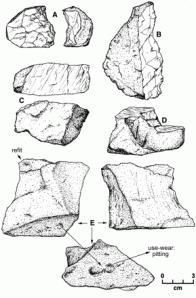Panda 100 is an archaeological site like any other. 4 kilograms of rock were excavated, baring traces of having been used as tools to crack nuts and a series of radiocarbon dates indicate it’s ~4,300 years old. The key difference though: this was a site created by chimpanzees. This is chimp archeology in action: applying all the stuff we’ve learned digging up ancient humans to chimpanzees. And so far this has led to the discovery of 3 “prehistoric” chimpanzee sites in the Tai National Park; with Panda 100 being the oldest at 4,300 years.

Chimps cracking nuts
Despite being early days for chimp archeology (or if you’re punnily inclined, Panthropology); these sites have already shed a lot of light on our closest living relatives. The most impressive discovery being the sheer age of the site. Chimps were still cracking nuts at Panda 100 until recently (when the last nut tree in the grove died), meaning chimps were doing the same thing in the same place for thousands of years! We knew that they could pass information from generation to generation; but to keep the same behavior going for >200 generations is pretty damn impressive.
But at the same time, they were doing the same thing for 4,300 years! There’s little evidence of innovation or improving upon the method. The rocks and techniques used by the Panda 100 chimps were almost the same as those used by modern chimps. We know they’re exceptional innovators, and new tools have been invented whilst they were being studied. So why no nutcracking improvements? Perhaps it’s the case that, whilst they’re good at inventing they aren’t so good at retaining these innovations. Many instances of modern chimp innovation were only adopted by a couple of members of the group, and soon abandoned. Or maybe smacking nuts with rocks is the pinnacle of nutcracking technology; and there’s no way to improve on it.

Some of the rocks from Panda 100
Panthropology is already helping shed light on human evolution too. The authors note that humans seem to have inhabited Panda 100 as well for a brief period. However, they feel confident in claiming that most of the nut cracking was done by chimps as the rocks themselves are quite large. Humans, with our dainty little hands, prefer to use smaller rocks for nut cracking than chimps.
But what’s most interesting is that the rocks from Panda 100 are of a similar size and shape to some of the stones from the oldest hominin stone age sites; like Olduvai Gorge (1.8 million years old). We don’t know much about the hands of Homo habilis and Australopithecus garhi - the hominins who created the earliest stone tools – but the similarity in size to the Panda 100 rocks suggests that they may well have have been more chimp-like.
The Panda 100 site shows chimp archeology is possible and that panthropological research into the chimpanzee “stone age” clearly has a lot to tells us about both our closest living relatives and ourselves. It’s been 5 years since the excavations at Panda 100; and the success there has already spread. Now there’s capuchin archaeology, macaque archeology and as researchers attempt to study the history of other stone-tool using primates. But personally, I’m a panthropology purist. I can’t wait for the next discoveries about the chimp stone age.
References
Boesch, C. 1995. Innovation in wild chimpanzees (Pan troglodytes). International Journal of Primatology, 16 (2), pp. 1–16.
Haslam, M., Hern, Ez-Aguilar, A., Ling, V., Carvalho, S., De La Torre, I., Destefano, A., Du, A., Hardy, B., Harris, J., Marchant, L. and Others. 2009. Primate archeology. Nature, 460 (7253), pp. 339–344.
Kummer, H. and Goodall, J. 1985. Conditions of innovative behavior in primates. Philosophical Transactions of the Royal Society of London, 308 pp. 213-214.
Mercader, J., Barton, H., Gillespie, J., Harris, J., Kuhn, S., Tyler, R. and Boesch, C. 2007. 4,300-year-old chimpanzee sites and the origins of percussive stone technology. Proceedings of the National Academy of Sciences, 104 (9), pp. 3043–3048.
Mercader, J., Panger, M. and Boesch, C. 2002. Excavation of a chimpanzee stone tool site in the African rainforest. Science, 296 (5572), pp. 1452–1455.

